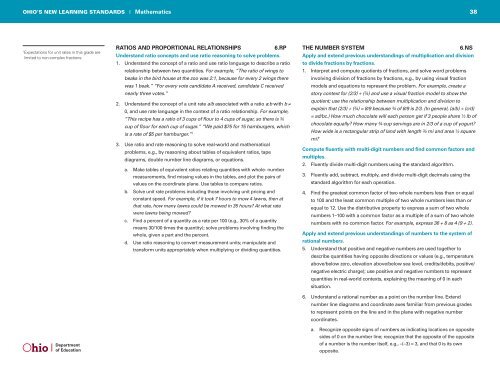Math-Standards.pdf
Math-Standards.pdf
Math-Standards.pdf
Create successful ePaper yourself
Turn your PDF publications into a flip-book with our unique Google optimized e-Paper software.
OHIO’S NEW LEARNING STANDARDS I <strong>Math</strong>ematics 38<br />
1<br />
Expectations for unit rates in this grade are<br />
limited to non-complex fractions.<br />
RATIOS AND PROPORTIONAL RELATIONSHIPS<br />
6.RP<br />
Understand ratio concepts and use ratio reasoning to solve problems.<br />
1. Understand the concept of a ratio and use ratio language to describe a ratio<br />
relationship between two quantities. For example, “The ratio of wings to<br />
beaks in the bird house at the zoo was 2:1, because for every 2 wings there<br />
was 1 beak.” “For every vote candidate A received, candidate C received<br />
nearly three votes.”<br />
2. Understand the concept of a unit rate a/b associated with a ratio a:b with b ≠<br />
0, and use rate language in the context of a ratio relationship. For example,<br />
“This recipe has a ratio of 3 cups of flour to 4 cups of sugar, so there is ¾<br />
cup of flour for each cup of sugar.” “We paid $75 for 15 hamburgers, which<br />
is a rate of $5 per hamburger.” 1<br />
3. Use ratio and rate reasoning to solve real-world and mathematical<br />
problems, e.g., by reasoning about tables of equivalent ratios, tape<br />
diagrams, double number line diagrams, or equations.<br />
a. Make tables of equivalent ratios relating quantities with whole- number<br />
measurements, find missing values in the tables, and plot the pairs of<br />
values on the coordinate plane. Use tables to compare ratios.<br />
b. Solve unit rate problems including those involving unit pricing and<br />
constant speed. For example, if it took 7 hours to mow 4 lawns, then at<br />
that rate, how many lawns could be mowed in 35 hours? At what rate<br />
were lawns being mowed?<br />
c. Find a percent of a quantity as a rate per 100 (e.g., 30% of a quantity<br />
means 30/100 times the quantity); solve problems involving finding the<br />
whole, given a part and the percent.<br />
d. Use ratio reasoning to convert measurement units; manipulate and<br />
transform units appropriately when multiplying or dividing quantities.<br />
THE NUMBER SYSTEM<br />
6.NS<br />
Apply and extend previous understandings of multiplication and division<br />
to divide fractions by fractions.<br />
1. Interpret and compute quotients of fractions, and solve word problems<br />
involving division of fractions by fractions, e.g., by using visual fraction<br />
models and equations to represent the problem. For example, create a<br />
story context for (2/3) ÷ (¾) and use a visual fraction model to show the<br />
quotient; use the relationship between multiplication and division to<br />
explain that (2/3) ÷ (¾) = 8/9 because ¾ of 8/9 is 2/3. (In general, (a/b) ÷ (c/d)<br />
= ad/bc.) How much chocolate will each person get if 3 people share ½ lb of<br />
chocolate equally? How many ¾-cup servings are in 2/3 of a cup of yogurt?<br />
How wide is a rectangular strip of land with length ¾ mi and area ½ square<br />
mi?<br />
Compute fluently with multi-digit numbers and find common factors and<br />
multiples.<br />
2. Fluently divide multi-digit numbers using the standard algorithm.<br />
3. Fluently add, subtract, multiply, and divide multi-digit decimals using the<br />
standard algorithm for each operation.<br />
4. Find the greatest common factor of two whole numbers less than or equal<br />
to 100 and the least common multiple of two whole numbers less than or<br />
equal to 12. Use the distributive property to express a sum of two whole<br />
numbers 1–100 with a common factor as a multiple of a sum of two whole<br />
numbers with no common factor. For example, express 36 + 8 as 4 (9 + 2).<br />
Apply and extend previous understandings of numbers to the system of<br />
rational numbers.<br />
5. Understand that positive and negative numbers are used together to<br />
describe quantities having opposite directions or values (e.g., temperature<br />
above/below zero, elevation above/below sea level, credits/debits, positive/<br />
negative electric charge); use positive and negative numbers to represent<br />
quantities in real-world contexts, explaining the meaning of 0 in each<br />
situation.<br />
6. Understand a rational number as a point on the number line. Extend<br />
number line diagrams and coordinate axes familiar from previous grades<br />
to represent points on the line and in the plane with negative number<br />
coordinates.<br />
a. Recognize opposite signs of numbers as indicating locations on opposite<br />
sides of 0 on the number line; recognize that the opposite of the opposite<br />
of a number is the number itself, e.g., –(–3) = 3, and that 0 is its own<br />
opposite.


